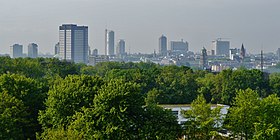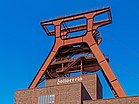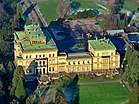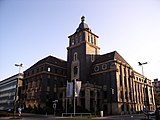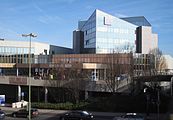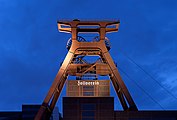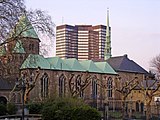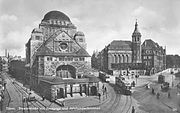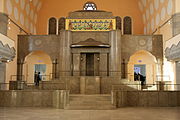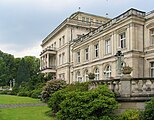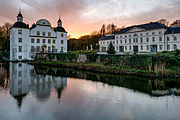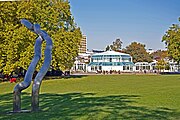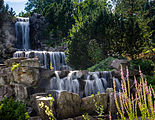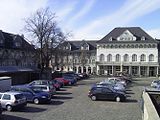Essen
Essen | |
|---|---|
Clockwise from top: Skyline of the city, Essen Business District, Essen Minster, Villa Hügel, Essen Saalbau, UNESCO world heritage site Zollverein Coal Mine Industrial Complex, Borbeck Castle, ThyssenKrupp headquarters | |
Urban district | |
| Subdivisions | 9 districts, 50 boroughs |
| Government | |
| • Lord mayor (2020–25) | Thomas Kufen[1] (CDU) |
| Area | |
| • Total | 210.34 km2 (81.21 sq mi) |
| Elevation | 116 m (381 ft) |
| Population (2021-12-31)[2] | |
| • Total | 579,432 |
| • Density | 2,800/km2 (7,100/sq mi) |
| Time zone | UTC+01:00 (CET) |
| • Summer (DST) | UTC+02:00 (CEST) |
| Postal codes | 45001–45359 |
| Dialling codes | 0201, 02054 (Kettwig) |
| Vehicle registration | E |
| Website | www.essen.de |

Essen (German pronunciation:
Essen is seat to several of the region's authorities, as well as to eight of the 100 largest publicly held German corporations by revenue, including three
Founded around 845, Essen remained a small town within the sphere of influence of an important
Notable accomplishments of the city in recent years include the title of
Geography
General
Oberhausen |
Bottrop |
Gladbeck |
Gelsenkirchen |
Mülheim an der Ruhr |
 (Map of districts and boroughs) |
Bochum | |
Ratingen |
Heiligenhaus |
Velbert |
Hattingen |
Essen is located in the centre of the
The Ruhr forms the
The lowest point can be found in the northern borough of Karnap at 26.5 m (86.9 ft), the highest point in the borough of Heidhausen at 202.5 m (664 ft). The average elevation is 116 m (381 ft).
City districts
Essen comprises fifty boroughs which in turn are grouped into nine suburban districts (called
Climate
Essen has a typical oceanic climate (Köppen: Cfb) with cool winters and warm summers (different from Berlin or Stuttgart). Without large mountains and the presence of inland seas, it ends up extending a predominantly marine climate is found in Essen, usually a little more extreme and drier in other continents in such geographical location.[8] Its average annual temperature is 10 °C (50 °F): 13.3 °C (56 °F) during the day and 6.7 °C (44 °F) at night. The average annual precipitation is 934 mm (37 in). The coldest month of the year is January, when the average temperature is 2.4 °C (36 °F). The warmest months are July and August, with an average temperature of 18 °C (64 °F).[9] The record high is 36.6 °C (98 °F) and the record low is −24 °C (−11 °F).[10]
| Climate data for Essen (Bredeney, 1991−2020 normals, extremes 1961-1990) | |||||||||||||
|---|---|---|---|---|---|---|---|---|---|---|---|---|---|
| Month | Jan | Feb | Mar | Apr | May | Jun | Jul | Aug | Sep | Oct | Nov | Dec | Year |
| Record high °C (°F) | 13.5 (56.3) |
18.7 (65.7) |
23.2 (73.8) |
28.9 (84.0) |
29.8 (85.6) |
32.3 (90.1) |
33.5 (92.3) |
34.3 (93.7) |
30.6 (87.1) |
26.1 (79.0) |
19.8 (67.6) |
15.8 (60.4) |
34.3 (93.7) |
| Mean daily maximum °C (°F) | 5.1 (41.2) |
6.1 (43.0) |
10.0 (50.0) |
14.5 (58.1) |
18.2 (64.8) |
21.1 (70.0) |
23.5 (74.3) |
23.0 (73.4) |
19.0 (66.2) |
14.2 (57.6) |
9.1 (48.4) |
5.7 (42.3) |
14.1 (57.4) |
| Daily mean °C (°F) | 2.9 (37.2) |
3.4 (38.1) |
6.4 (43.5) |
10.2 (50.4) |
13.8 (56.8) |
16.6 (61.9) |
18.7 (65.7) |
18.4 (65.1) |
14.9 (58.8) |
10.8 (51.4) |
6.7 (44.1) |
3.7 (38.7) |
10.5 (50.9) |
| Mean daily minimum °C (°F) | 0.6 (33.1) |
0.8 (33.4) |
3.1 (37.6) |
5.9 (42.6) |
9.2 (48.6) |
12.0 (53.6) |
14.3 (57.7) |
14.2 (57.6) |
11.3 (52.3) |
7.9 (46.2) |
4.3 (39.7) |
1.6 (34.9) |
7.1 (44.8) |
| Record low °C (°F) | −17.1 (1.2) |
−15.9 (3.4) |
−11.1 (12.0) |
−4.6 (23.7) |
−0.6 (30.9) |
1.0 (33.8) |
4.4 (39.9) |
6.0 (42.8) |
3.2 (37.8) |
−2.3 (27.9) |
−6.7 (19.9) |
−16.7 (1.9) |
−17.1 (1.2) |
| Average precipitation mm (inches) | 84.8 (3.34) |
66.7 (2.63) |
65.6 (2.58) |
52.5 (2.07) |
67.0 (2.64) |
79.1 (3.11) |
85.6 (3.37) |
92.2 (3.63) |
74.0 (2.91) |
77.3 (3.04) |
79.4 (3.13) |
94.0 (3.70) |
925.3 (36.43) |
| Average precipitation days (≥ 0.1 mm) | 18.6 | 16.1 | 16.4 | 13.3 | 14.3 | 14.5 | 15.2 | 15.3 | 14.8 | 16.3 | 18.6 | 19.9 | 193.1 |
| Average relative humidity (%)
|
84.0 | 80.5 | 74.8 | 68.8 | 69.4 | 71.3 | 70.7 | 71.4 | 77.5 | 81.9 | 85.3 | 86.1 | 76.8 |
| Mean monthly sunshine hours | 55.4 | 72.8 | 125.9 | 172.9 | 204.7 | 197.7 | 208.2 | 193.0 | 149.7 | 109.7 | 60.6 | 45.1 | 1,593.7 |
| Source: | |||||||||||||
History
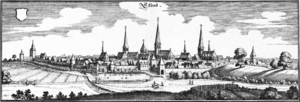
Origin of the name
In German-speaking countries, the name of the city Essen often causes confusion as to its origins, because it has the same form as the German
Early history
The oldest archaeological find, the Vogelheimer Klinge, dates back to 280,000 – 250,000 BC. It is a blade found in the borough of Vogelheim in the northern part of the city during the construction of the Rhine–Herne Canal in 1926.[15] Other artifacts from the Stone Age have also been found, although these are not overly numerous. Land utilization was very high—especially due to mining activities during the Industrial Age—and any more major finds, especially from the Mesolithic era, are not expected. Finds from 3,000 BC and onwards are far more common, the most important one being a Megalithic tomb found in 1937. Simply called Steinkiste (Chest of Stone), it is referred to as "Essen's earliest preserved example of architecture".[16]
Essen was part of the settlement areas of several Germanic peoples (
The Alteburg castle in the south of Essen dates back to the eighth century, the nearby Herrenburg to the ninth century.
Recent research into Ptolemy's Geographia has identified the polis or oppidum Navalia as Essen.[17]
Eighth–twelfth centuries

Around 845, Saint
Around 852, construction of the collegiate church of the abbey began, to be completed in 870. A major fire in 946 heavily damaged both the church and the settlement. The church was rebuilt, expanded considerably, and is the foundation of the present Essen Cathedral.
The first documented mention of Essen dates back to 898, when Zwentibold, King of Lotharingia, willed territory on the western bank of the River Rhine to the abbey. Another document, describing the foundation of the abbey and allegedly dating back to 870, is now considered an 11th-century forgery.
In 971,
13th–17th centuries

In 1216, the abbey, which had only been an important landowner until then, gained the status of a princely residence when Emperor
In 1563, the city council, with its self-conception as the only legitimate ruler of Essen, introduced the
Thirty Years' War
During the Thirty Years' War, the Protestant city and the Catholic abbey opposed each other. In 1623, princess-abbess Maria Clara von Spaur, Pflaum und Valör, managed to direct Catholic Spaniards against the city in order to initiate a Counter-Reformation. In 1624, a "re-Catholicization" law was enacted, and churchgoing was strictly controlled. In 1628, the city council filed against this at the Reichskammergericht. Maria had to flee to Cologne when the Dutch stormed the city in 1629. She returned in the summer of 1631 following the Bavarians under Gottfried Heinrich Graf zu Pappenheim, only to leave again in September. She died 1644 in Cologne.
The war proved a severe blow to the city, with frequent arrests, kidnapping and rape. Even after the Peace of Westphalia from 1648, troops remained in the city until 9 September 1650.
Industrialisation
The first historic evidence of the important mining tradition of Essen date back to the 14th century, when the princess-abbess was granted mining rights. The first silver mine opened in 1354, but the indisputably more important coal was not mentioned until 1371, and coal mining only began in 1450.
At the end of the 16th century, many coal mines had opened in Essen, and the city earned a name as a centre of the weapons industry. Around 1570, gunsmiths made high profits and in 1620, they produced 14,000 rifles and pistols a year. The city became increasingly important strategically.
Resident in Essen since the 16th century, the Krupp family dynasty and Essen shaped each other. In 1811, Friedrich Krupp founded Germany's first cast-steel factory in Essen and laid the cornerstone for what was to be the largest enterprise in Europe for a couple of decades. The weapon factories in Essen became so important that a sign facing the main railway station welcomed visitors Hitler and Mussolini to the "Armory of the Reich" (German: Waffenschmiede des Reiches) in 1937.[18] The Krupp Works also were the main reason for the large population growth beginning in the mid-19th century. Essen reached a population of 100,000 in 1896. Other industrialists, such as Friedrich Grillo, who in 1892 donated the Grillo-Theater to the city, also played a major role in the shaping of the city and the Ruhr area in the late 19th and early 20th century.
World War I and occupation
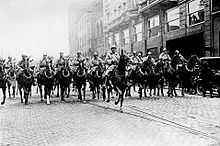
Riots broke out in February 1917 following a breakdown in the supply of flour. There were then strikes in the Krupp factory.[19]
On 11 January 1923 the Occupation of the Ruhr was carried out by the invasion of French and Belgian troops into the Ruhr. The French Prime Minister, Raymond Poincaré, was convinced that Germany failed to comply the demands of the Treaty of Versailles. On the morning of 31 March 1923, the culmination of this French-German confrontation[20] occurred when a small French military command, occupied the Krupp car hall to seize several vehicles. This event caused 13 deaths and 28 injured. The occupation of the Ruhr ended in summer 1925.[21]
Nazism, World War II
On the night of
During the Nazi era, tens of thousands of slave laborers were forced to work in 350 Essen forced labour camps. Here, they did mining work and worked for companies like Krupp and Siemens.

As a major industrial centre, Essen was a target for
The Krupp decoy site (German: Kruppsche Nachtscheinanlage) was built in Velbert to divert Allied airstrikes from the actual production site of the arms factory in Essen.
The Allied ground advance into Germany reached Essen in April 1945. The US
After the successful invasion of Germany by the allies, Essen was assigned to the
Twenty-first century

Although weaponry is no longer produced in Essen, old industrial enterprises such as ThyssenKrupp and RWE remain large employers in the city. Foundations such as the Alfried Krupp von Bohlen und Halbach-Stiftung still promote the well-being of the city, for example by supporting a hospital and donating €55,000,000 for a new building for the Museum Folkwang, one of the Ruhr area's major art museums.
Politics

Historical development
The administration of Essen had for a long time been in the hands of the
During the
During the
Mayor
The current Mayor of Essen is Thomas Kufen of the Christian Democratic Union (CDU), who was elected in 2015 and re-elected in 2020.
The most recent mayoral election was held on 13 September 2020, and the results were as follows:
| Candidate | Party | Votes | % | |
|---|---|---|---|---|
| Thomas Kufen | Christian Democratic Union | 115,415 | 54.3 | |
| Oliver Kern | Social Democratic Party | 43,093 | 20.3 | |
| Mehrdad Mostofizadeh | Alliance 90/The Greens | 25,924 | 12.2 | |
| Harald Parussel | Alternative for Germany | 12,695 | 6.0 | |
| Daniel Kerekeš | The Left | 5,414 | 2.5 | |
| Annie Maria Tarrach | Die PARTEI | 5,168 | 2.4 | |
| Karlgeorg Raimund Krüger | Free Democratic Party | 4,200 | 2.0 | |
| Peter Köster | German Communist Party | 546 | 0.3 | |
| Detlef Albert Fergeé | National Democratic Party | 232 | 0.1 | |
| Valid votes | 212,687 | 99.1 | ||
| Invalid votes | 1,861 | 0.9 | ||
| Total | 214,548 | 100.0 | ||
| Electorate/voter turnout | 446,384 | 48.1 | ||
| Source: State Returning Officer | ||||
City council

The Essen city council governs the city alongside the Mayor. The most recent city council election was held on 13 September 2020, and the results were as follows:
| Party | Votes | % | +/- | Seats | +/- | |
|---|---|---|---|---|---|---|
| Christian Democratic Union (CDU) | 73,206 | 34.4 | 30 | |||
| Social Democratic Party (SPD) | 51,550 | 24.3 | 21 | |||
| Alliance 90/The Greens (Grüne) | 39,569 | 18.6 | 16 | |||
| Alternative for Germany (AfD) | 15,849 | 7.5 | 6 | |||
| The Left (Die Linke) | 8,309 | 3.9 | 3 | |||
| Free Democratic Party (FDP) | 6,476 | 3.0 | 3 | ±0 | ||
| Essen Citizens' Alliance (EBB) | 6,209 | 2.9 | 3 | |||
| Die PARTEI (PARTEI) | 5,282 | 2.5 | 2 | |||
| Human Environment Animal Protection (Tierschutz) | 4,396 | 2.1 | New | 2 | New | |
| Social Liberal Alliance (SLB) | 760 | 0.4 | New | 0 | New | |
| German Communist Party (DKP) | 463 | 0.2 | 0 | ±0 | ||
| Volt Germany (Volt) | 357 | 0.2 | New | 0 | New | |
| Pirate Party Germany (Piraten) | 86 | 0.0 | 0 | |||
| Valid votes | 212,512 | 98.9 | ||||
| Invalid votes | 2,327 | 1.1 | ||||
| Total | 214,839 | 100.0 | 86 | |||
| Electorate/voter turnout | 446,384 | 48.1 | ||||
| Source: State Returning Officer | ||||||
Coat of arms

The coat of arms of the city of Essen is a heraldic peculiarity. Granted in 1886, it is a so-called Allianzwappen (

Demographics
| Year | Pop. | ±% |
|---|---|---|
| 1816 | 4,721 | — |
| 1831 | 5,460 | +15.7% |
| 1839 | 8,813 | +61.4% |
| 1871 | 51,513 | +484.5% |
| 1895 | 96,128 | +86.6% |
| 1905 | 231,360 | +140.7% |
| 1919 | 439,257 | +89.9% |
| 1925 | 470,524 | +7.1% |
| 1935 | 654,461 | +39.1% |
| 1939 | 666,743 | +1.9% |
| 1950 | 605,411 | −9.2% |
| 1956 | 698,925 | +15.4% |
| 1963 | 730,970 | +4.6% |
| 1970 | 696,733 | −4.7% |
| 1975 | 677,568 | −2.8% |
| 1980 | 647,643 | −4.4% |
| 1990 | 626,973 | −3.2% |
| 2000 | 595,243 | −5.1% |
| 2010 | 574,635 | −3.5% |
| 2015 | 582,624 | +1.4% |
| 2017 | 583,393 | +0.1% |
| 2019 | 582,760 | −0.1% |
| Population size may be affected by changes in administrative divisions. Source:[33] | ||
| Nationality | Population |
|---|---|
| 14,984 | |
| 13,076 | |
| 6,952 | |
| 6,317 | |
| 5,642 | |
| 4,652 | |
| 3,774 | |
| 3,429 | |
| 3,047 | |
| 2,974 | |
| 2,890 | |
| 2,504 | |
| 2,471 | |
| 1,911 | |
| 1,863 | |
| 1,800 | |
| 1,719 | |
| 1,561 | |
| 1,458 | |
| 1,306 |
Essen has a population about 580,000 and is the 2nd largest city in Ruhr area after Dortmund and the 10th largest city in Germany. Essen has also the largest urban density with cities such as Bochum, Gelsenkirchen and Oberhausen borders this city. In 1960, the population reached its historical peak of over 720,000 (Essen was the fifth largest German city at that time) due to its booming industrial era of the Ruhr Area and West Germany (Wirtschaftswunder). Since 1970s, the population of Essen declined due to loss of jobs by coal and mining. Essen has a large migrant population, most of them are from Turkey, Syria and Poland.
International relations
The City of Monessen, Pennsylvania, situated along the Monongahela River, was named after the river and Essen.[35]
Twin towns – sister cities
- Changzhou, China (2015)
- Grenoble, France (1974)
- Nizhny Novgorod, Russia (1991)
- Sunderland, England, United Kingdom (1949)
- Tampere, Finland (1960)
- Tel Aviv, Israel (1991)
- Zabrze, Poland (2015)
Cooperation agreements
Essen cooperates with:[37]
- Kōriyama, Japan (2017)
- Qingdao, China (2008)
- Rivne, Ukraine (2022)
- Ulaanbaatar, Mongolia (2012)
Industry and infrastructure
Economy
Essen is home to several large companies, among them the
-
ThyssenKrupp headquarters in Essen
-
RWE AG headquarters in the business district
-
E.ON headquarters
-
RWE AG headquarters
-
Hochtief headquarters
-
Evonik Industries headquarters
-
Schenker AG headquarters
-
Postbank Essen
-
Deutsche Bank branch in the financial district
-
Emschergenossenschaft Essen
Fairs

The city's exhibition centre,
-
Messe Essen south entrance
-
Messe Essen east entrance
-
Messe Essen south entrance
Media
The
Education
One renowned educational institution in Essen is the
-
Zollverein School of Management and Design
-
Universität Essen
-
Folkwang University
The University of Duisburg-Essen, which resulted from a 2003 merger of the universities of Essen and Duisburg, is one of Germany's "youngest" universities with about 42,000 Students.[44] One of its primary research areas is urban systems (i.e., sustainable development, logistics and transportation), a theme largely inspired by the highly urbanised Ruhr area. Other fields include nanotechnology, discrete mathematics and "education in the 21st century". Another university in Essen is the private Fachhochschule für Ökonomie und Management, a university of applied sciences with over 6,000 students and branches in 15 other major cities throughout Germany.
Medicine
Essen offers a highly diversified health care system with more than 1,350 resident doctors and almost 6,000 beds in 13 hospitals, including a university hospital. The university hospital dates back to 1909, when the city council established a municipal hospital; although it was largely destroyed during
-
Elisabethkrankenhaus Essen
-
University Hospital Essen
Transport
Streets and motorways

The road network of Essen consists of over 3,200 streets, which in total have a length of roughly 1,600 km (994 mi).
Four
In the north, the A 42 briefly touches Essen territory, serving as an interconnection between the neighboring cities of Oberhausen and Gelsenkirchen and destinations beyond.
A part of the A 44, a highly segmented connection from Aachen and the Belgian border to Kassel, planned to go further into Central Germany, ends in Essens south.
A segment of the
With the A 40/A 52 in the southern parts of the city and the A 42 in the north, there is a gap in the motorway system often leading to congestion on streets leading from the central to the northern boroughs. An extension of the A 52 to connect the Essen-Ost junction with the A 42 to close this gap is considered urgent;[45] it has been planned for years but not yet been realized – most importantly due to the high-density areas this extension would lead through, resulting in high costs and concerns with the citizens.
Public transport
As with most communes in the Ruhr area, local transport is carried out by a local, publicly owned company for transport within the city, the
As of 2009[update], Ruhrbahn operates 3 U-Stadtbahn lines of the Essen Stadtbahn network, 7 Straßenbahn (tram) lines and 57 bus lines (16 of these serving as Nacht Express late-night lines only). The Stadtbahn and Straßenbahn operate on total route lengths of 19.6 kilometres (12.2 mi) and 52.4 kilometres (32.6 mi), respectively.[46] One tram line and a few bus lines coming from neighboring cities are operated by these cities' respective carriers. The U-Stadtbahn, which partly runs on used Docklands Light Railway stock, is a mixture of tram and full underground systems with 20 underground stations for the U-Stadtbahn and additional four underground stations used by the tram. Two lines of the U-Stadtbahn are completely intersection-free and hence independent from other traffic, and the U18 line leading from Mülheim main station to the Bismarckplatz station at the gates of the city centre partly runs above ground amidst the A 40 motorway. The Essen Stadtbahn is one of the Stadtbahn systems integrated into the greater Rhine-Ruhr Stadtbahn network.
-
Main station
-
Essen Stadtbahn NF2-TW 1601
-
Essen Hauptbahnhof
-
Essen Hauptbahnhof in the city centre
-
Essen Hauptbahnhof subway station
-
Platforms at Kaiser-Wilhelm-Park
On the same motorway, a long-term test of a guided bus system is being held since 1980. Many Ruhrbahn rail lines meet at the main station but only a handful of bus lines. However, all but one of the Nacht Express bus lines originate from / lead to Essen Hauptbahnhof in a star-shaped manner. All Ruhrbahn lines, including the Nacht Express lines, are closed on weekdays from 1:30 a.m. to 4:30 a.m.
Of the
In 2017, the public transport organization of Mülheim, the Mülheimer Verkehrsgesellschaft (MVG) and the Essener Verkehrsgesellschaft (EVAG) merged and became the Ruhrbahn. All vehicles and staff were merged and are now operated together.
Aviation
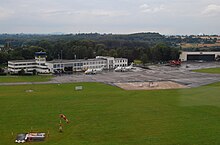
Together with the neighbouring city of
Landmarks
Zollverein Industrial Complex
The Zollverein Coal Mine Industrial Complex is the city's most famous landmark. For decades, the coal mine (current form mainly from 1932, closed in 1986) and the coking plant (closed in 1993) ranked among the largest of their kinds in Europe. Shaft XII, built in Bauhaus style, with its characteristic winding tower, which over the years has become a symbol for the whole Ruhr area, is considered an architectural and technical masterpiece, earning it a reputation as the "most beautiful coal mine in the world".[49] After UNESCO had declared it a World Heritage Site in 2001, the complex, which had lain idle for a long time and was even threatened to be demolished, began to see a period of redevelopment. Under the direction of an agency borne by the land of North Rhine-Westphalia and the city itself, several arts and design institutions settled mainly on the grounds of the former coal mine; a redevelopment plan for the coking plant is to be realised.
On the grounds of the coal mine and the coking plant, which are both accessible free of charge while paid guided tours (some with former Kumpels) are available, several tourist attractions can be found, most importantly the Design Zentrum NRW/Red Dot Design Museum. The Ruhrmuseum, a museum dedicated to the history of the Ruhr area, which had been existing since 1904, opened its gates as one of the anchor attractions in the former coal-washing facility in 2010.
-
Coal mine Zollverein
-
Shaft XII of Zollverein
-
Zollverein entrance
-
Ruhrmuseum
-
Ruhrmuseum staircase
Essen Minster and treasury
The former collegiate church of
-
Cross of Otto and Mathilde, tenth century
-
St. Ludger Basilica
-
Essen Minster overshadowed by the town hall
Old Synagogue
Opened in 1913, the then-New Synagogue served as the central meeting place of Essen's pre-war Jewish community. The building ranks as one of the largest and most impressive testimonies of Jewish culture in pre-war Germany. In post-war Germany, the former house of worship was bought by the city, used as an exhibition hall and later rededicated as a cultural meeting centre and house of Jewish culture.
-
Synagogue, 1917
-
Synagogue, 1922
-
Old Synagogue, 2010
-
Old Synagogue, 2014
-
Old Synagogue interior
Villa Hügel
Built in 1873 by industrial magnate
-
Villa Hügel
-
Villa Hügel
-
Villa Hügel
-
Great hall
Kettwig and Werden

In the south of the city, the boroughs of Kettwig and Werden exceptionally stand for towns once of their own, which have been annexed in 1929 (Werden) and 1975 (Kettwig), respectively, and which have largely preserved their pre-annexation character. While most of the northern boroughs were heavily damaged during the
In Werden, St.
Kettwig, which was annexed in 1975, much to the dismay of the population that still struggles for independence,[52] was mainly shaped by the textile industry. The most southern borough of Essen is also the city's largest (with regard to area) and presumably greenest.
-
Essen Werden
-
Essen Werden
-
Essen Werden historic town centre
-
Protestant church Essen Werden
-
Essen Werden
-
Essen Werden, old town hall
-
Historic town centre of Kettwig
-
Essen Kettwig
Other important cultural sites
- Museum Folkwang: One of the Ruhr area's major art collections, mainly from the 19th and 20th centuries. Major parts of the museum have recently been rebuilt and expanded according to plans by David Chipperfield & Co. The Alfried Krupp von Bohlen und Halbach Foundation is the sole funder of the €55 million project which was completed in early 2010. After its re-opening, it also hosts the collection of the Deutsches Plakat Museum (more than 340 000 exhibits).
- Aalto Theatre: Opened in 1988 (the plans dating back to 1959), the asymmetric building with its deep indigo interior is home to the acclaimed Essen Opera and Ballet.
- Saalbau Essen: Home of the Essen Philharmonic Orchestra, completely renovated in 2003/2004. Critics have repeatedly voted the Essen Philharmonic as Germany's Orchestra of the Year.[53]
- Colosseum Theater: Situated in a former Krupp factory building at the fringe of the central pedestrian precinct, the Colosseum Theater has been home to several musical theatre productions since 1996.
- cultural centre and venue for Rock concerts and home of Offener Kanal Essen.
- Grillo-Theater, a theatre in the centre of the city.
-
Grugahalle concert hall
-
Schloss Borbeck
-
Hugenpoet castle
Other sites
- Gartenstadt Margarethenhöhe: Founded by Margarethe Krupp in 1906, the garden city with its 3092 units in 935 buildings on an area of 115 ha (284.2 acres) (of which 50 ha are woodland) is considered the first of its kind in Germany. All buildings follow the same stylistic concept, with slight variations for each one. Although originally designed as an area for the lower classes with quite small flats, the old part Margarethenhöhe I has developed into a middle class residential area and housing space has become highly sought after. A new part, Margarehenhöhe II, was built in the 1960s and 1970s but is architecturally inferior and especially the multi-storey buildings are still considered social hot spots.
- Moltkeviertel (Moltke Quarter): from 1908 on, following reformative plans of the city deputy Robert Schmidt, this quarter was developed just south-east of the city centre. Large green zones, forming broad urban ventilation lanes and incorporating sporting and playing areas and high quality architecture – invariably in the style of Reform Architecture, combine to create a unique example worldwide of modern town planning. It reflects reformative ideas and dates from the early part of the 20th century. The Moltkeviertel continues to be a much sought-after area for residential, educational, health care and small-scale commercial purposes. On the Moltkeplatz, the quarter's largest square, an ensemble of high quality contemporary art is maintained and cared for by local residents.
- Grugapark: With a total area of 70 ha (173.0 acres), the park near the exhibition halls is one of the largest urban parks in Germany and, although entry is not free of charge, one of the most popular recreational sites of the city. It includes the city's botanical garden, the Botanischer Garten Grugapark.
- Baldeneysee: The largest of the six reservoirs of the River Ruhr, situated in the south of the city, is another popular recreational area. It is used for sailing, rowing and ship tours. The hilly and only lightly developed forest area around the lake, from which the Kettwig area is easily reachable, is popular with hikers.
-
Grugapark, Kranichwiese facing the Orangerie and the sculpture Orion
-
Grugapark, Sculpture "Trauer" by Joseph Enseling
-
Grugapark, Reichsgartenschau 1938, Keramikhof
-
Grugapark illuminated, 2015
-
Grugapark, Waterfall
-
Baldeneysee
-
Baldeneysee
-
Baldeneysee
-
Marketplace of Margarethenhöhe I
-
Margarethenhöhe houses
-
Sculptures by Friedrich Gräsel and Gloria Friedmann at the Moltkeplatz
Notable people
Natives
People born in Essen:
- Gerd Albrecht (1935–2014), conductor
- Karl Albrecht (1920–2014), entrepreneur
- Theo Albrecht (1922–2010), entrepreneur; brother of Karl
- Peter Anders (1908–1954), operatic tenor
- Karl Baedeker (1801–1859), publisher
- Jürgen Bartsch (1946–1976), serial killer
- Ute Berg (born 1953), politician
- Naftali Bezem (1924–2018), artist
- Ali Bilgin (born 1981), footballer
- Franz Blücher (1896–1959), politician
- Hermann Blumenthal (1905–1942), sculptor
- Wilhelm Börger (1896–1962), Nazi politician
- Karl Brandt (1899–1975), agricultural economist
- Sabine Braun (born 1965), track athlete
- Dennis Brinkmann (born 1978), footballer
- Ernest B. H. Busch (1885–1945), Generalfeldmarschall
- Gunter d'Alquen (1910–1998), editor
- Marc Degens (born 1971), writer
- Marius Ebbers (born 1978), footballer
- Friedrich Karl Florian (1894–1975), Nazi Gauleiter
- James Ingo Freed (1930–2005), architect
- Matt Frei (born 1963), journalist
- Harald Grohs (born 1944), race car driver
- Brigitte Hamann (1940–2016), author
- Hildegard Hamm-Brücher (1921–2016), politician
- Walter Heiman (1901–2007), centenarian and WW1 survivor
- Alfred Herrhausen (1930–1989), banker
- Axel Honneth (born 1949), philosopher
- Carl Humann (1839–1896), engineer
- Wilhelm Kalveram (1882–1951), university professor
- Christian Keller (born 1972), swimmer
- Fritz G. A. Kraemer (1908–2003), military educator
- Diether Krebs (1947–2000), actor
- Helene Kröller-Müller (1869–1939), art collector
- Alfred Krupp (1812–1887), inventor
- Alfried Krupp von Bohlen und Halbach (1907–1967), Nazi industrialist
- Bertha Krupp (1886–1957), daughter of Friedrich Alfred
- Friedrich Alfred Krupp (1854–1902), steel manufacturer
- Friedrich C. Krupp (1787–1826), founder of Krupp family business
- Heinz Kubsch (1930–1993), football goalkeeper
- Hubert Lampo (1920–2006), writer
- Johanna Langefeld (1900–1974), Nazi guard
- Arthur Laumann (1894–1970), flying ace
- Issachar Berend Lehmann (1661–1730), banker
- Jens Lehmann (born 1969), footballer
- Helga Niessen Masthoff (born 1941), tennis player
- Armin Meiwes (born 1961), convicted murderer known as the Cannibal of Rothenburg
- Frank Mill (born 1958), footballer
- Harry S. Morgan (1945–2011), pornographic film director
- Alfred Müller-Armack (1901–1978), politician
- Henry Osterman (1862-????), architect
- Friedrich Panse (1899–1973), psychiatrist
- Mille Petrozza (born 1967), guitarist
- Helmut Rahn (1929–2003), footballer
- Uta Ranke-Heinemann (1927–2021), theologian
- Otto Rehhagel (born 1938), footballer
- Uwe Reinders (born 1955), footballer
- Günther Rennert (1911–1978), opera director
- Heinz Rühmann (1902–1994), actor
- Leroy Sané (born 1996), footballer
- Klaus Scharioth (born 1946), diplomat
- Magdalene Schauss-Flake (1921–2008), composer and organist
- Hilde Krahwinkel Sperling (1908–1981), tennis player
- John Steppling (1870–1932), actor
- David D. Stern (born 1956), artist
- Martin Stratmann (born 1954), electrochemist
- Marianne Strauss (1923–1996), Holocaust survivor
- Josef Terboven (1898–1945), Nazi Gauleiter
- Bernhard Termath (1928–2004), footballer
- Johan van Galen (1604–1653), commodore
- Kyriakos Velopoulos (born 1965), politician
- Albert Vögler (1877–1945), politician
- Elisabeth Volkmann (1936–2006), actress
- Pia Walkenhorst (born 1993), volleyball player
- Daniel Wende (born 1984), skater
Honorary citizens
The city of Essen has been awarding honorary citizenships since 1879 but has (coincidentally) discontinued this tradition after the foundation of the
- 1879 Otto von Bismarck – Chancellor of Germany
- 1888 Friedrich Hammacher – politician, lawyer and economist
- 1895 Roman catholic theologian
- 1896 industrialist(spouse of Margarethe Krupp, see below)
- 1901 Heinrich Carl Sölling – tradesman and benefactor
- 1906 Lord Mayor(1886–1906)
- 1912 Margarethe Krupp – benefactress (spouse of Friedrich Alfred Krupp, see above)
- 1917 Generalfeldmarschall and army leader, later President of Germany
- 1949 Viktor Niemeyer – posthumous recognition)
- 2007 Berthold Beitz – president of the Alfried Krupp von Bohlen und Halbach Foundation
Today, the highest award of the city is the Ring of Honour, which Berthold Beitz, for example, had already received in 1983. Other bearers of the Ring of Honour include Essen's former Lord Mayor and later President of Germany, Gustav Heinemann, as well as Franz Cardinal Hengsbach, the first Bishop of Essen. Berthold Beitz (1973) and his wife Else Beitz (2006) are recipients of the Righteous Among the Nations recognized by the Yad Vashem for having saved about 800 Jewish lives during World War II.
Sport
The biggest
Another important and famous sports club is TUSEM Essen, with a handball team that have won several national and international titles.
The city's main basketball team is
Essen hosted the
References
- ^ Wahlergebnisse in NRW Kommunalwahlen 2020 Archived 17 May 2022 at the Wayback Machine, Land Nordrhein-Westfalen, accessed 19 June 2021.
- Landesbetrieb Information und Technik NRW. Retrieved 20 June 2022.
- ^ "Heimatabend Essen – Die heimliche Hauptstadt des Ruhrgebiets" (in German). 10 September 2014. Archived from the original on 17 April 2021. Retrieved 19 June 2020.
- ^ "European Green Capital". ec.europa.eu. Archived from the original on 20 May 2017. Retrieved 12 May 2017.
- ^ "Kommunen: Der Tausendfüßler". Der Spiegel. October 2014. Archived from the original on 29 April 2016. Retrieved 12 May 2017.
- ^ "Top ten: Das sind Deutschlands grünste Städte". Handelsblatt. Archived from the original on 30 April 2017. Retrieved 12 May 2017.
- ^ "European Green Capital". ec.europa.eu. Archived from the original on 10 May 2017. Retrieved 12 May 2017.
- ^ "Essen, Germany Köppen Climate Classification (Weatherbase)". Weatherbase. Archived from the original on 31 January 2019. Retrieved 31 January 2019.
- ^ "World Weather Information Service – Essen". worldweather.wmo.int. Archived from the original on 10 March 2021. Retrieved 4 May 2022.
- ^ "Extreme temperature records since 1850". meteorologyclimate.com. Archived from the original on 29 March 2017. Retrieved 12 May 2017.
- ^ "Essen-Bredeney Climate Normals 1991–2020". National Oceanic and Atmospheric Administration. Archived from the original on 16 September 2023. Retrieved 16 September 2023.
- ^ "Essen (10410) – WMO Weather Station". NOAA. Archived from the original on 30 September 2023. Retrieved 31 January 2019. Archived 31 January 2019, at the Wayback Machine
- ^ Stadt Essen. "Origin of place names" (in German). Essen.de. Archived from the original on 24 January 2014. Retrieved 6 April 2011.
- ^ Paul Derks: Der Ortsname Essen, in: Essener Beiträge 103 (1989/90), pp. 27–51
- ^ "Ergrabene Zeiten" Archived 4 March 2016 at the Wayback Machine, City of Essen, undated (in German)
- ^ Detlef Hopp: Essen vor der Geschichte – Die Archäologie der Stadt bis zum 9. Jahrhundert, in Borsdorf (Ed.): Essen – Geschichte einer Stadt, 2002, p. 32
- ^ "Mapping Ancient Germania: Berlin Researchers Crack the Ptolemy Code" Archived 2 August 2014 at the Wayback Machine, Der Spiegel
- ^ "NRW 2000 – Epoche des Nationalsozialismus – Einleitung – Hitler und Mussolini besuchen die "Waffenschmiede des Reiches" und die Krupp-Werke Essen". Nrw2000.de. 25 September 1937. Archived from the original on 16 July 2011. Retrieved 6 April 2011.
- ^ "Auszug aus der Zusammenstellung der Monatsberichte der stellv. Generalkommandos an das preußische Kriegsministerium betr. die allgemeine Stimmung im Volke" (Excerpt from the compilation of monthly reports of the Deputy Commanding Generals to the Prussian War Ministry concerning the morale of the population). 3 March 1917, no. 230/17 g. B. 6., Generallandesarchiv Karlsruhe, Abt. 456, vol. 70. Reprinted in Wilhelm Deist, Militär und Innenpolitik im Weltkrieg 1914–1918 (Military and Domestic Policy in the World War, 1914–1918). 2 volumes. Düsseldorf: Droste, 1970, vol. 2, pp. 666–667.
- ^ "Her mit der Kohle", Der Spiegel EinesTages; retrieved 4 May 2012 Archived 2 February 2014 at the Wayback Machine
- ^ "The occupation of the Ruhr (Germany, 1923–1925)" Archived 9 October 2021 at the Wayback Machine, International Committee of the Red Cross, 21 January 2005
- ^ "Geschichte des Hauses" (in German). Archived from the original on 21 October 2014. Retrieved 21 October 2014.
- ^ "Ausstellung erinnert an Zwangsarbeiter" (in German). 12 September 2010. Archived from the original on 26 February 2014. Retrieved 21 October 2014.
- ^ "Der LVR in Europa" (in German). Archived from the original on 28 June 2014. Retrieved 21 October 2014.
- ^ "Krupp's Trial at Nuremberg" (PDF). Library of Congress. Archived (PDF) from the original on 11 July 2019.
- ^ "bomber command | mines laid | flight august | 1945 | 1571 | Flight Archive". www.flightglobal.com. Archived from the original on 10 January 2015.
- ^ Essen, Germany – Transatlantic Cities Network Archived 19 June 2010 at the Wayback Machine, German Marshall Fund of the United States accessed 3 April 2010
- ^ Essen – History Archived 4 March 2010 at the Wayback Machine, eurotravelling.net, accessed 3 April 2010
- ^ The Essen Lynching Case Archived 11 June 2009 at the Wayback Machine, University of the West of England, accessed 3 April 2010
- ^ Stanton, Shelby, World War II Order of Battle: An Encyclopedic Reference to U.S. Army Ground Forces from Battalion through Division, 1939–1946 (Revised Edition, 2006), Stackpole Books, p. 97.
- ^ "Chronik der Stadt Essen" [Time-line of the City of Essen]. essen.de. Archived from the original on 24 November 2011. Retrieved 12 May 2017.
- ^ "Origin of the sword in the Essen Cathedral Treasury". Regesta-imperii.adwmainz.de. Archived from the original on 11 March 2007. Retrieved 6 April 2011.
- ^ Statistisches Landesamt Nordrhein-Westfalen Archived 16 June 2019 at the Wayback Machine. .[not specific enough to verify]
- ^ "Essener Statistik Bevölkerung 1987–2017" (PDF) (in German). Table E2, p. 19. Archived from the original (PDF) on 31 August 2021. Retrieved 2 July 2021.
- ^ Harvath, Les (18 March 2007). "School colors glimpse history". Pittsburgh Tribune-Review. Archived from the original on 2 February 2010. Retrieved 13 February 2017.
- ^ "Essens Partnerstädte". essen.de (in German). Essen. Archived from the original on 4 March 2021. Retrieved 2 February 2021.
- ^ "Essen.International" (PDF). essen.de (in German). Essen. September 2019. p. 22. Archived (PDF) from the original on 8 February 2021. Retrieved 2 February 2021.
- ^ "Press releases". www.eon.com. Archived from the original on 16 February 2017. Retrieved 12 May 2017.
- ^ Nick Hall, "Getting to grips with the essential Essen", The Irish Times, 6 December 2006, via HighBeam Research
- ^ Jens Meiners, "The Continental: Essen Motor Show, European Politics, and BMW Remarks" Archived 29 July 2017 at the Wayback Machine, Car and Driver, 3 December 2013.
- ^ John Rettie, "Germany's Essen Motor Show" Archived 19 August 2014 at the Wayback Machine, Road & Track, 6 December 2011.
- ^ "Messe Essen | FAQs". Archived from the original on 29 July 2017. Retrieved 29 July 2017.
- ^ Deutschlandradio Archived 5 March 2012 at the Wayback Machine New Name and Building, 10 January 2010 (in German)
- ^ "Lokalnachrichten". Radio Essen. Archived from the original on 4 March 2016. Retrieved 12 May 2017.
- incomplete short citation]
- ^ "Kleine EVAG Statistik 2010* (*stand 31.12.2009)" [Small EVAG Statistics 2010* (*as of 31.12.2009)] (PDF) (in German). Essener Verkehrs-Aktiengesellschaft (EVAG). 31 December 2009. Archived from the original (PDF) on 16 November 2011. Retrieved 20 October 2013.
- ^ "Federal Ministry of Transport, Building and Urban Affairs". Archived from the original on 6 September 2009.
- ^ According to RVV-Verkehrsstatistik 2007 (RVV Traffic Statistics 2007).
- ^ "European Route of Industrial Heritage". En.erih.net. Archived from the original on 5 February 2012. Retrieved 6 April 2011.
- ^ "Official Villa Hügel Web Page". Archived from the original on 12 September 2008.
- ^ "Die gesündeste Stadt Deutschlands". Süddeutsche Zeitung. 17 May 2010. Archived from the original on 30 July 2017. Retrieved 12 May 2017.
- ^ "Official Site of the State Parliament of North Rhine-Westphaila". Landtag.nrw.de. Archived from the original on 12 May 2013. Retrieved 6 April 2011.
- ^ "Pressetext – Oper". Opernwelt. 28 September 2009. Archived from the original on 16 July 2011. Retrieved 6 April 2011.
- ^ "Speech by Mayor Wolfgang Reiniger (German)" (PDF). Archived from the original (PDF) on 27 March 2009. Retrieved 6 April 2011.
- ^ Stadt Essen. "Honorary Citizens of Essen". Essen.de. Archived from the original on 12 May 2011. Retrieved 6 April 2011.
Bibliography
External links
- Official website
- Essen city panoramas, panoramic views and virtual tours
- Pictures from Kettwig
- Memorials in Essen, sites-of-memory.de

